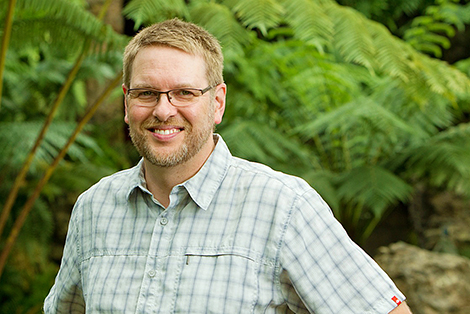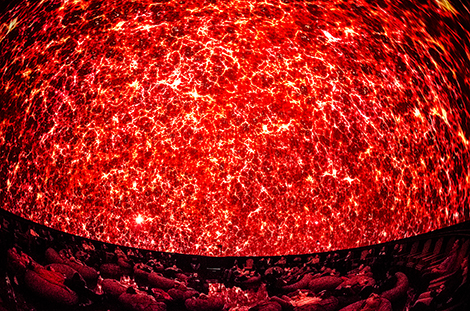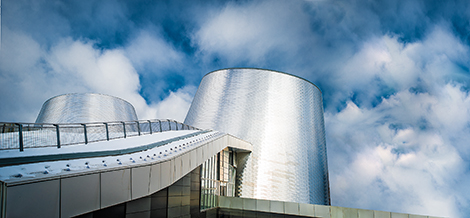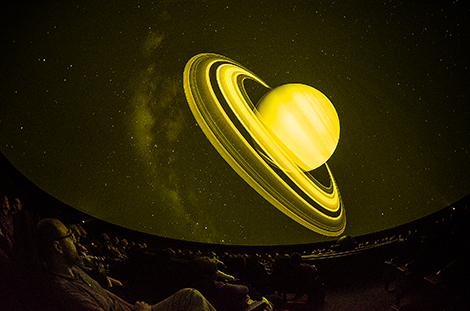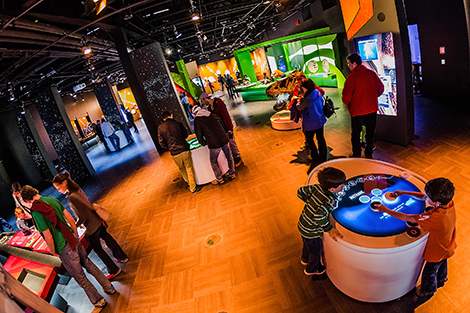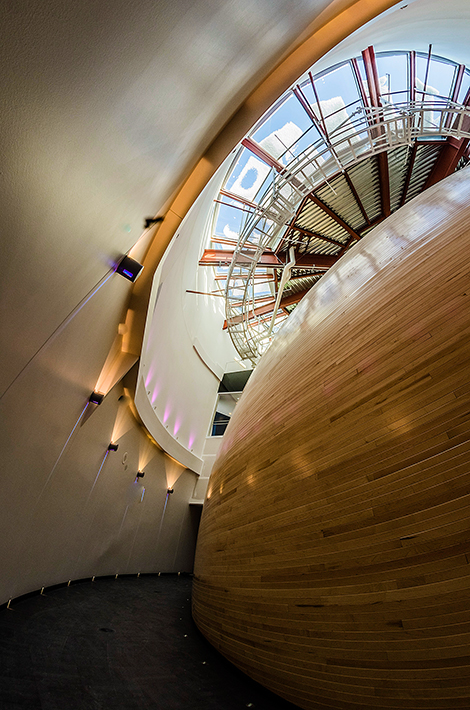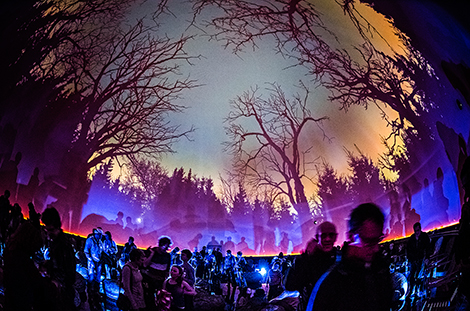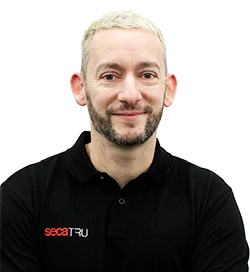features
The sky at night
Rocket into the universe or relax under the stars on a riverbank at Canada’s new $48m planetarium, Rio Tinto Alcan. Astronomer Pierre Chastenay describes the experience, which opened in April
What is Rio Tinto Alcan Planetarium?
Rio Tinto Alcan Planetarium opened in April and is one of four entities under the umbrella of The Space For Life. The other sites are the Montreal Biodôme, Botanical Garden and Insectarium.
We’ve created one of the largest science museum complexes in the world, which is something to brag about.
Together, the biodôme, insectarium, botanical garden and planetarium form a place where nature and science are honoured – a Space for Life. It’s a participatory movement in which communities are invited to participate. It’s also a commitment to helping people to better understand and protect our planet’s biodiversity.
The previous planetarium, which closed in October 2011, was in downtown Montreal. It was almost 10km away from the other sites, making it very difficult for people to visit the four museums in one day. Now they’re all in the eastern part of the city of Montreal, near the Olympic Stadium.
Together, they already have almost two million visitors a year and we’re expecting that to increase following the opening of the planetarium. Visitors can buy one ticket, which is valid for two days, and go to the four different museums at their own pace.
What’s the design?
It’s a beautiful building. Two metal cones, which look like telescopes tubes from a distance, point towards the sky and are located above the planetarium’s two theatres. Overall, there’s 4,000sq m (43,000sq ft) of space for exhibits, classrooms and function rooms.
The basement links the planetarium with the biodôme, so visitors can walk from one to the other without having to go outside. That’s a big plus for our visitors, especially school groups and senior citizens.
What’s the content?
We have two 18m (59ft) dome theatres – most planetariums only have one, a multimedia theatre and an astronomical theatre. We use fulldome video technology to put images on the dome in the multimedia theatre. The dome is a little more than a hemisphere and goes down to 1m (3ft) from the floor. When visitors walk into the theatre, they’re completely immersed in the image. The theatre doesn’t have a centrally positioned optomechanical star projector, so this gives us a whole new flexibility for the kind of presentations we can have.
Unlike a traditional planetarium, the multimedia dome has a level floor and doesn’t have fixed seating, so we can use the space for temporary exhibitions, multimedia shows, dance displays and theatre presentations.
The second dome is the astronomical theatre. It’s more traditional and has an optomechanical star projector in the middle, which was built by Japanese company Konica Minolta to our very exact specifications. We project the sky onto the dome and show the stars in the most pristine conditions possible.
The star projector is supported by another fulldome array of video projectors. We call that approach a hybrid system. The video system is slave to the optomechanical star projector, so when we have the stars up on the dome and want to display, for instance, the lines between the stars to draw the constellation Orion, all the lines will come from the video system. If we move the sky, reproducing the motion of the stars going from east to west, the video images will sync and follow the stars very closely. That gives us flexibility to show the constellations, frontiers between the constellations and all the astronomical coordinate lines we use in astronomy. We can also tag the stars and write their names beside them.
The astronomical theatre has concentric, fixed seating with everyone facing centre. The floor is raised 50cm (1.6ft) above the main floor, so when guests are seated, their heads are close to the horizon of the dome. Instead of having the impression of looking at the stars from the bottom of a well, it’s more like being seated in a field and having the stars surrounding you.
Sky-Skan is responsible for the integration of the optomechanical star projector and the video projectors in the astronomical theatre, plus the arrangement of the video projectors in the multimedia theatre.
What’s the visitor experience?
Visitors will be directed to either the multimedia theatre or the exhibit area, depending on the time marked on their ticket. We run shows on the hour and want to make sure that visitors don’t miss any part of the experience we have in store for them.
In the old Montreal Planetarium, we had a 45-minute presentation. Two-thirds was pre-recorded, then an astronomy interpreter would take people on a tour of the current night sky. As we now have two theatres, we’ve been able to separate these two experiences.
The multimedia theatre hosts the pre-recorded part of the experience – a 23 minute-long presentation by well-known multimedia creators Michel Lemieux and Victor Pilon. Visitors are taken on a trip from the surface of a lake in the Laurentian mountains north of Montreal, up to the extreme outreach of the universe, down underneath the lake and then back to the surface again. The narration is musical, set to excerpts from the symphonic music of the renowned American composer Philip Glass, which is very exciting for us. The experience is rich both visually and aurally.
Visitors then go into the astronomical theatre for a 40-minute show, where a live astronomy interpreter talks them through the current night sky under the magnificent Konica Minolta starry sky. After 20 minutes, we blast off from Earth in our virtual spacecraft to visit up close all the objects and phenomena that were discussed in the previous part.
For instance, if Jupiter and Saturn are visible on a particular occasion, then we fly to these two giant planets and explore them, their moons and their rings. Or we may take visitors all the way to the edge of the known universe – to the outskirts of our Milky Way.
The fulldome video technology we use in both theatres allows us to travel anywhere in the universe and look at whatever we want to see. For example, if a new exoplanet was discovered around a star in the Milky Way, we could show that new planet up close, as soon as it’s added to the database. It’s easy to show the planet revolving around its star, even though it was only discovered a few hours before.
Every show is different because it’s be driven by what’s happening in the universe on a day-to-day basis. In the astronomical theatre, we run separate presentations in French and English.
At the end of the presentation in the astronomical theatre, visitors go into the 500sq m (5,400sq ft) exhibit area. This is devoted to one of the most important questions in astronomy – are we alone in the universe or are there other planets where life has emerged, and maybe evolved, perhaps not to the point of intelligent life, but at least primitive life, such as bacteria? It’s such a major topic and drives the exploration of Mars and the new exoplanets that we’re discovering every week.
We use multimedia design exhibits. Instead of having printed panels with text and pictures, multi-touch screens enable visitors to navigate animations, images, text and videos. Most of the information is presented in a digital form. This is very dynamic and can be updated easily, which is essential, as it’s a topic that’s changing very fast. If we finally discover the smoking gun of life on Mars, for example, we’ll be able to present that information immediately. This exhibit will be presented for the first five to seven years of operation of the planetarium.
Part of the exhibit will be devoted to meteorites because there’s a strong link between meteorites and the appearance of life on Earth. We have one of the largest meteorite collections in Canada, which is on display.
There’s also a fully functioning geological laboratory with a large window to allow visitors to see how we study meteorites and take care of them. At certain points in the day, the public can interact with animators and scientists around the meteorite laboratory.
To experience everything we offer at the planetarium takes between two and three hours. After the exhibit, visitors can spend time in the café, participate in a special presentation in one of our three classrooms, or go on to visit the Montreal Biodôme, the Botanical Garden or the Insectarium.
What was the inspiration?
The inspiration for going anywhere in the universe in the astronomical theatre was based on our own experience of using that technology at demonstrations in Chicago and New York. We were inspired by the fact that, with a simple joystick or iPad, we can control the images that are projected on the dome and can travel anywhere in the universe. It’s so powerful and so novel.
The inspiration for the multimedia theatre is Michel Lemieux and Victor Pilon’s own cottage in the country between Montreal and Ottawa. In the evening, they sit by a river filled with rocks and gaze at the reflection of the sky on the surface. When people walk inside the multimedia theatre, they see a highly reflective floor. Whatever is projected on the dome will be reflected on the floor, just like it would be on the surface of a river or lake. Visitors sit on Adirondack chairs or beanbags that resemble rocks coming out of the river.
What were the challenges?
The buildings are on the Olympic Park, which was built in the 1970s. There’s concrete everywhere and very few trees in sight. As we’re The Space For Life, it’s a challenge to talk about life in such a sterile environment.
We tried to remove as much concrete as we could. For example, much of the roof is green, to absorb heat, thereby reducing the heat-island effect on the site. The area around the building is renaturalised, with landscaping integrating patches of greenery and trees.
The planetarium construction is the first part of a larger plan that will invest CA$200m (US$203.1m, £125.3m, E154.4m) in that area in the next five to eight years. There’s a grand design behind all this and we’re only one step in that movement. By the end, the look of the whole area will have changed completely. I think people will love it.
What are the future plans?
We’ll have new shows and experiences starting in the spring of 2014 and school presentations that will target content in the Quebec school curriculum. Astronomy topics are covered at the primary and secondary level and we want to help the teachers teach good astronomy. We have a plan for the first five years, but it’s too early to reveal.
